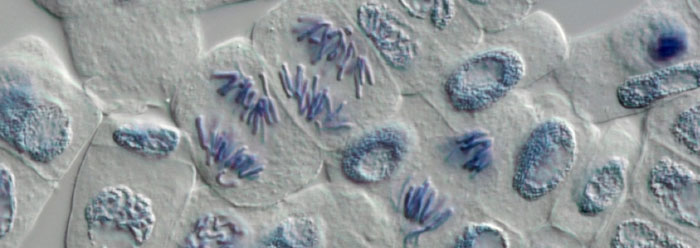Cell division seems comparatively straightforward when viewed under a microscope. One cell replicates itself and splits into two daughter cells, enabling an organism to develop, grow, and replace cells in its body. But there is no easy way to describe the details of how cells actually achieve this orderly division.
Processes at work inside the cell somehow ensure that enough of every required part makes it into both daughter cells, whether it is a complete set of chromosomes, at least one each of every organelle (in eukaryotic cells), and thousands of required proteins.
How do cells keep all of this straight, and how do they continually repeat the process with such precision? If any division phase occurs too soon or out of order, the cell will fail to survive. The success of the process is crucial for any dividing cell, which includes all cells and therefore all living systems.
Cell division occurs in discrete phases, with specific objectives obtained in each phase. One key question that cell biologists have tackled is: How does the cell "know" when to stop one phase and start the next?
Reporting in the journal Cell, researchers found that a particular enzyme called Cdk operates as a master oscillator, undergoing rhythmic periods of activity.1 Cdk activates a host of subsidiary oscillators, each one in charge of activating a separate but necessary process at a distinct phase of cell division. Moreover, Cdk is influenced by feedback information sent from its subsidiary oscillators.
And this is just one mechanism, tightly linked with many other major cell processes, that ensures cell division is properly regulated. Without Cdk and its associate enzymes comprising what the authors call a "phase-locking model," cell division would not work. And without that, there would be no life on earth.
How did this interactive, micro-miniaturized network of oscillators come about? In a summarized version of the technical report on Cdk, University of California physiologist David Morgan wrote, "The phase-locking model, like everything in biology, makes particularly good sense in the light of evolution."2
He then summarized speculations regarding what supposedly happened early in the evolutionary history of cells:
Early eukaryotes depended on multiple autonomous oscillators, each driving a different event with similar frequency. Cdk arrived later in evolution…eventually assuming control of multiple oscillators to provide more robust centralized control….More effective coordination and timing of events would have become possible with the duplication and specialization of cyclins, together with the evolution of checkpoint controls. Cdks also acquired the ability to directly control hundreds of proteins involved in every aspect of cell division.2
So, with no actual evidence that any of this took place, what is the difference between this "report" and pure fiction?
In an extreme case of shortsightedness, the quote above immediately followed a discussion of how necessary Cdk and its host of oscillators are to the very life of the cell! Morgan described the oscillators as depending "so completely on the Cdk oscillator that they can no longer be uncoupled from it."2 Reports of biochemical systems that cannot evolve backward, but somehow must have evolved forward to reach their present state of existence highlight the blind faith that evolution requires.3
Logically speaking, if a necessary component of any system is broken, then the whole system breaks. But this also means that the required piece—which in this case is the phase-locking oscillator setup—must also have appeared in its entirety and fully integrated at the very start.
Further, the coupling between Cdk and its associate enzymes is so strong that it "underlies the regulatory circuit driving DNA replication."2
By the author's own admission, without these coordinated oscillators to regulate it, DNA replication would not occur. And without DNA replication, cell division would not occur. Without cell division, there would be no reproduction. And without reproduction there can be no evolution, because evolution supposedly operates by survival and reproduction of the fittest.
Thus, this oscillator makes no "sense in the light of evolution." The real light that this proposed evolutionary "just-so" story sheds is on the human heart, revealing that even when confronted with blatant evidence for creation (in the form of ingeniously designed cellular regulatory machinery), some people choose to remain "willingly...ignorant."4
References
- Lu, Y. and F. R. Cross. 2010. Periodic Cyclin-Cdk Activity Entrains an Autonomous Cdc14 Release Oscillator. Cell. 141 (2): 268-279.
- Morgan, D. O. 2010. The Hidden Rhythms of the Dividing Cell. Cell. 141 (2): 224- 226.
- Thomas, B. Irreversible Complexity―Evolution Loses Another Round. ICR News. Posted on icr.org December 16, 2009, accessed September 23, 2010.
- 2 Peter 3:5.
* Mr. Thomas is Science Writer at the Institute for Creation Research.
Article posted on September 29, 2010.



















